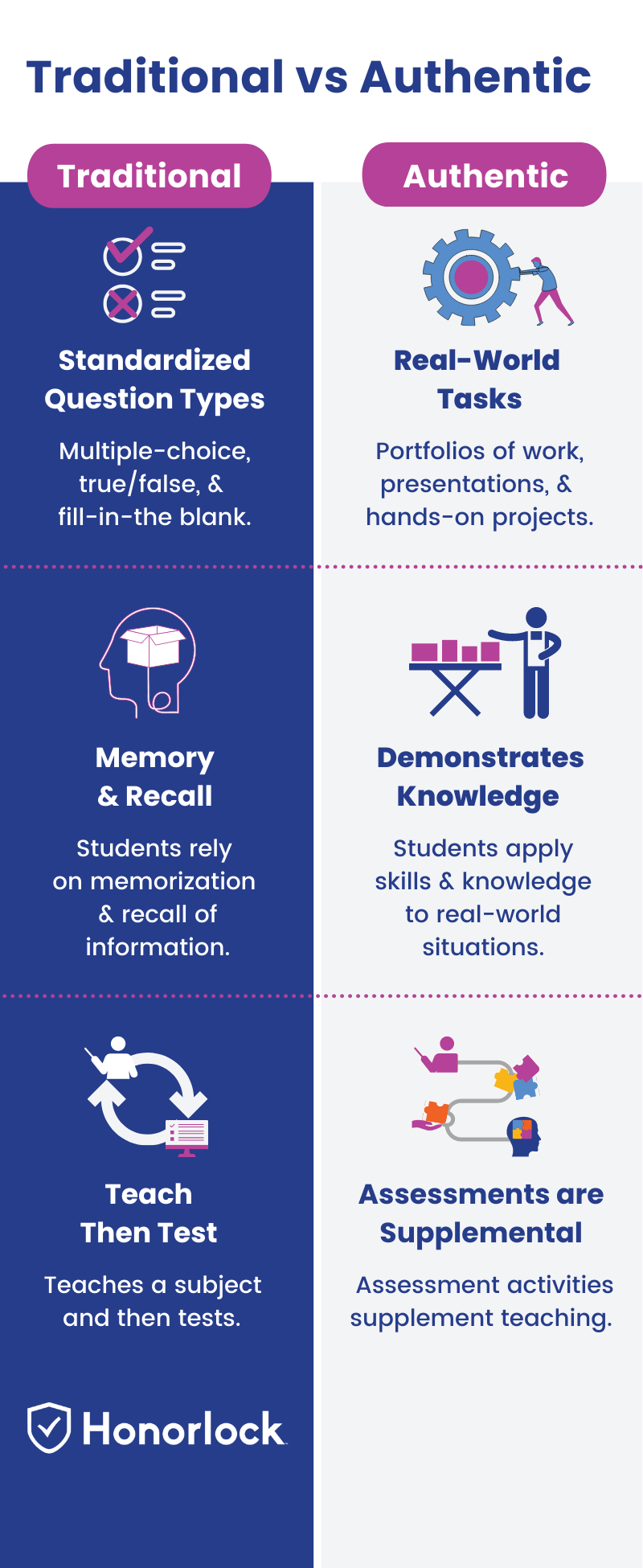What is authentic assessment?
Authentic assessment means that students are assessed by their ability to complete real-world tasks that demonstrate their skills and knowledge.
If you’re wondering how traditional assessments are different than authentic assessments, here’s a summary:
- Traditional assessment means students show what they know about a subject.
- Authentic assessment means students demonstrate that they can do real-world tasks and activities.
Generally speaking, there are a few differences between traditional assessment and authentic assessment.

Authentic assessment examples
Examples of authentic assessments include:
- Student portfolios of work
- Demonstrations where students complete a hands-on task/activity
- Game-based activities
- Projects using industry software or hardware
- Presentations
- Mock interviews and other role-playing scenarios
- Participation in classroom discussions and debates
- Writing (essays, journals, reports, self-assessments, peer evaluations, etc.)
Here are examples of how authentic assessments can be used in online courses for different fields:
Accounting
Complete a cash flow statement based on mock data for the last three years using real accounting software.
Six Sigma
Live video presentation of a project plan to streamline technology implementation.
Counseling
Review a client-patient case study and conduct a mock video counseling session based on details from the case study.
Instructional Design
Create an accessible online course within a common learning management system based on mock student profiles that describe individual disabilities and conditions, along with other course requirements, such as a website, audio/video, and communication tools.
Data Security
Create a comprehensive disaster recovery plan for a technology company based on a case study that details the company’s business activities, technologies, and past security incidents.
Graphic Design
Use graphic design software to create a series of advertisements based on spec requirements for various social media platforms.
Use a combination of traditional and authentic assessments in the online classroom
While there are differences between traditional and authentic assessments, they can still complement each other in the online classroom.
Consider this example:
Accounting instructors want students to know common terms and accounting laws, but they also want students to understand how to use real accounting software in a genuine work situation.
Instructors can use a combination of traditional and authentic assessments in online courses to ensure that students are comprehensively learning:
- Use traditional online assessments to ensure that students know about the subject
- Test students’ knowledge of asset and liability-related terms.
- Use online authentic assessments to ensure that students can do the subject
- Test students’ ability to apply their knowledge of assets and liabilities when creating a company balance sheet that includes examples of both.
Advantages and disadvantages of using authentic assessment
Prepares students for real-life work situations
The key benefit of online authentic assessments is that students are applying their skills and knowledge to real-world situations.
Involves a complex range of assessment strategies to test knowledge
Authentic assessments provide students with a variety of ways to demonstrate their skills and knowledge. Instead of picking a multiple choice answer or choosing true or false, students are performing real-world tasks that require the comprehensive application of what they’ve learned.
Assessments are typically more active and engaging
Generally speaking, completing hands-on, real-world tasks will be more engaging for students than a multiple-choice assessment. Completing these tasks can mean that students conduct mock interviews, use real industry software to complete a project, or teach classmates a specific subject – all are an engaging and active way to demonstrate competency.
They can take longer to review and grade
Traditional assessments usually require less time to grade because students are completing standardized questions that can be automatically graded. Authentic assessments, such as conducting a mock counseling session, may require more time because the instructor has to watch the session and grade it based on complex rubrics.
Protecting academic integrity is tricky
Another concern that instructors have with assessments, especially online assessments, is making sure that students aren’t able to get an unfair advantage by using cell phones, notes, books, and the internet.
Authentic assessments typically require more than standardized question-types, so it’s important to use technology that helps create a fair testing environment for students, whether it’s a hands-on demonstration or writing an essay.
Grading can be more complex
Authentic assessments can be more complex to grade in some situations because students are completing a task instead of selecting a correct answer.
For example, if the assessment requires students to create a series of designed advertisement images, grading can become more subjective, and detailed rubrics are needed so that students know exactly what’s expected and how they’ll be graded.
Read part two of this series for tips to create authentic assessments for online courses and actual examples of assessment activities and a rubric template. Read part 3 of this series to see real examples of how online proctoring can prevent cheating during online authentic assessments such as presentations, demonstrations, group work, open book, and handwritten or typed essays and math tests.
